
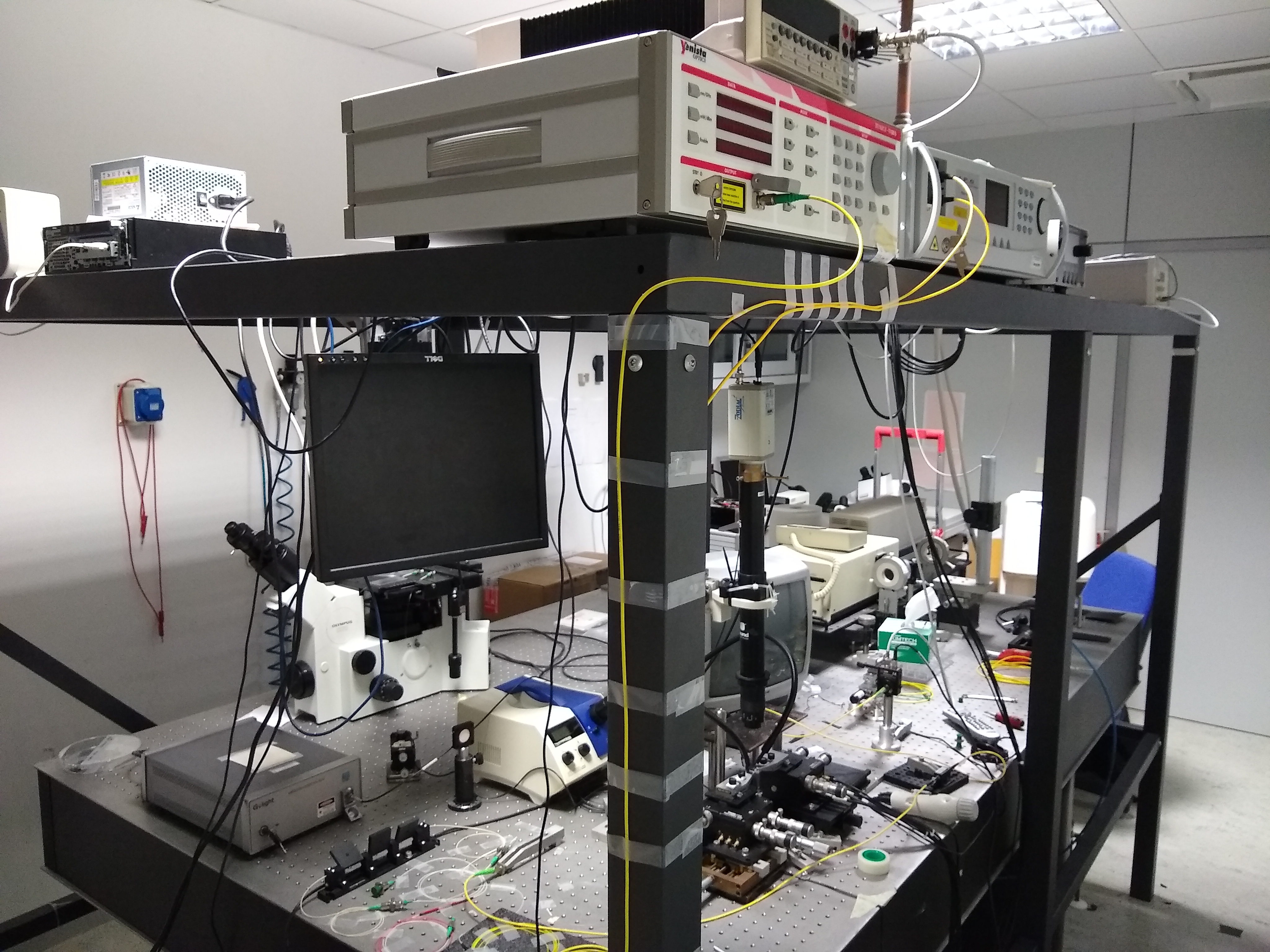 The “Quantum Lab” is currently dedicated to perform two type of activities related, name suggests, to the study of quantum nature of light.
The “Quantum Lab” is currently dedicated to perform two type of activities related, name suggests, to the study of quantum nature of light.
The first one concerns the study of entanglement applied to single photons, where two internal degrees of freedom of the same photon, are entangled. The latter is called Intra-particle Entanglement. In order to prove the presence of the entanglement, a Bell’s test is performed by using a bulky double Mach-Zehnder interferometer. The photons are then detected by the use of Single-Photon Avalanche Diodes (SPADs): the signals produced are then collected by a computer and an FPGA. The alignment of all the optical devices is performed using a low power green laser (546nm).
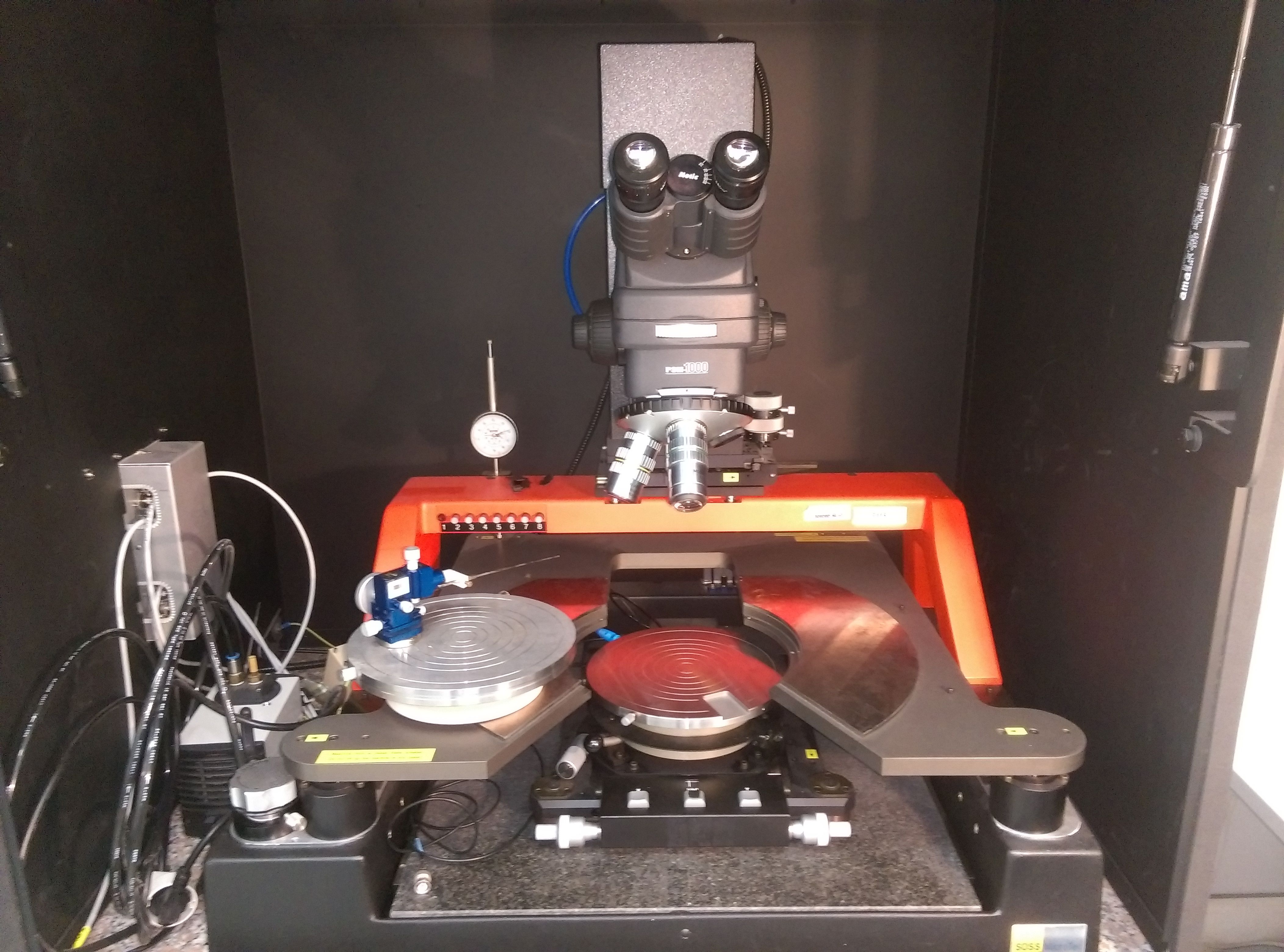
The laboratory is equipped with two darkened probe-stations for testing bare optoelectronic chips.
Conventional instrumentations consist of a 3 GHz class measurement chain, composed of a digital oscilloscope and a pulse/pattern generator. Two Agilent semiconductor analyzers and a high resolution LCR meter are available for the electrical characterization of semiconductors.
For conventional and quantum applications the optical instrumentation consists of a shared (with other labs) range of detectors for SWIR NIR and visible. SPAD photon counters for SWIR, NIR and visible. Fiber lasers, telecom power, with laser controller. Light transfer is usually done with fibers.
Multichannel counters and pulse cross-correlators down to 1.3 ns bin width, and Time to Digital converters with 70 ps resolution are available.
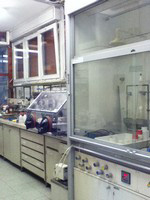
Three spectrometers -covering from the UV to the IR spectral range- and a solar simulator to test photocatalytic activity are also available.
The new laser lab is devoted to the study and characterization of laser systems, with particular interest on the semiconductor lasers, at telecom wavelength. 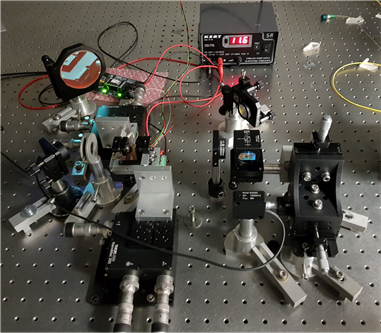
New laser indicates that the lab is devoted both to the test of laser realized building new resonator geometry and laser systems obtained by the coherent and incoherent combination of different laser beams.
The laboratory is equipped with all the instruments needed to implement and test new devices, such as an external seed tunable laser source, a beam profiler and power detectors.
In MIR lab two different setups are available.
1) CW setup: a tunable high power free space laser is coupled to a lensed tapered fiber that can inject ligth in the sample. For the output another fiber identical to the imput fiber is used. The CW laser can be tuned between 2 and 2.9 um and can reach 4W of power. A control for the polarization is also available.
2) Pulsed setup: a pulsed free space source procduces fs pulses with a broad band. These pulses are converted to a ps pulses using a pulse sheper and also the wavelength and the pulse width can be choosen. Then the imput pulse can be controlled used a FTIR or coupled in the same setup that is used in the CW laser.
Also a single emission laser at 1.55 um, an infrared camera and a detector for 1.55 um are avalaiable for the allineation procedure. Three detectors can be used for the measurements: an InGaAs extended, an InGaAs photon counter and a OSA.
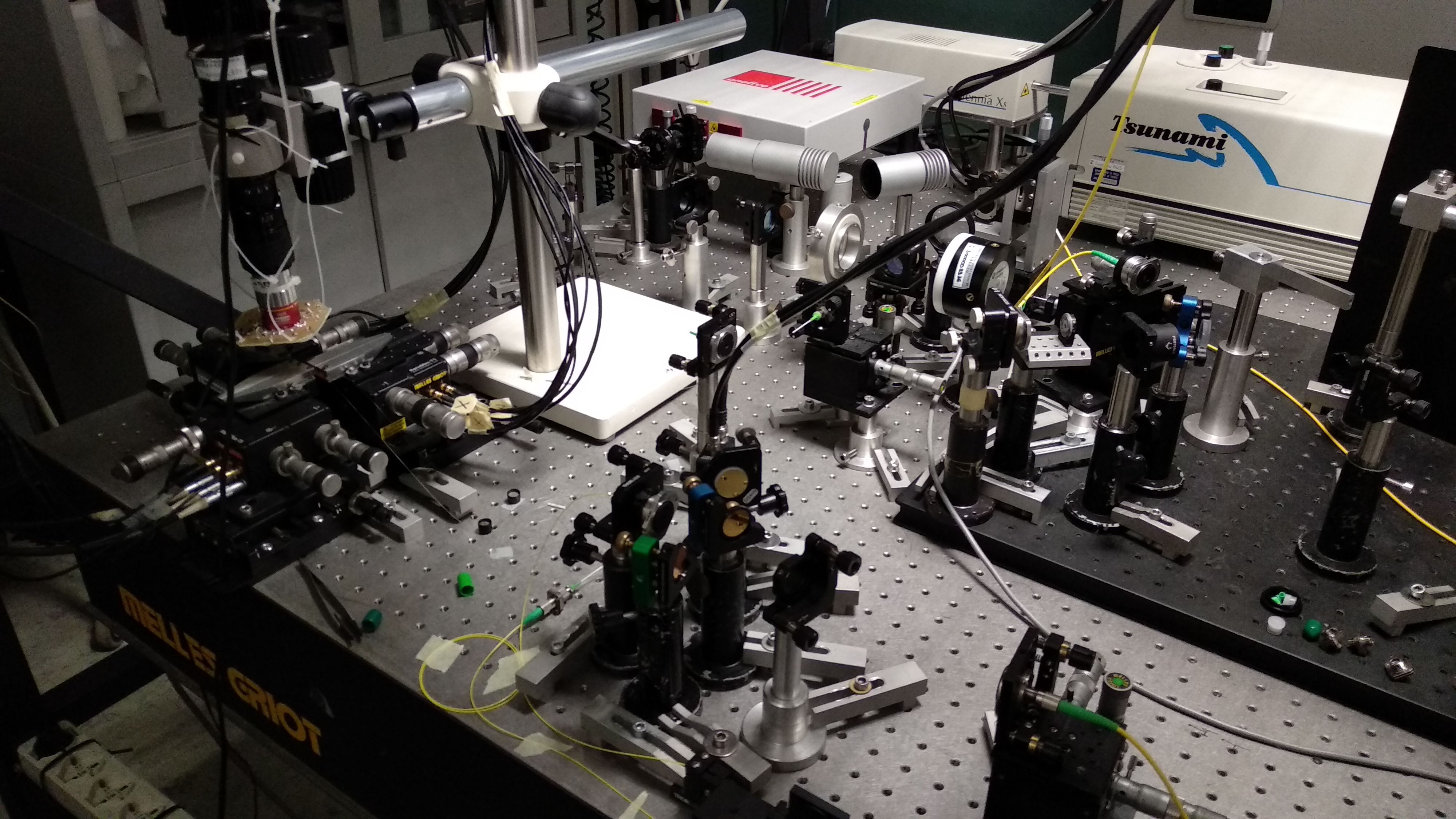
The Nonlinear Lab is dedicated to the characterization of nonlinear optical processes and their application in integrated devices. In particular, the most investigated devices are optical waveguides in silicon. A butt-coupling setup is present, used to inject/extract the light in/from the chip. A high power pulsed pump laser at 1550 nm is available in order to trigger the nonlinearities in the sample. A monochromator with single-photon sensitivity is present, able to characterize the spectrum of the light generated in the nonlinear process. In the lab is also available an up-conversion system for the detection of mid infrared light down to the single photon level.
The measurements performed in the lab can characterize both the classical and quantum properties of the nonlinear processes. In particular, applications like wavelength conversion and single photon generation are standard experiments carried out in the laboratory. The main nonlinear effect studied is the intermodal four wave mixing in silicon-on-insulator waveguides. Particular focus has been recently devoted to the characterization of single photon sources, therefore the laboratory is equipped with single photon detectors, timing electronics (correlators, start/stop time to digital converters) and all the optical components required for quantum effects measurements.
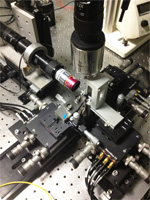 RF Photonics Lab is dedicated to the characterization of light-wave circuits. Two distinct setups allows for a broad range of linear and non-linear characterization and analysis. The light sources, detectors, signal transport and conditioning are based mainly on fiber optics, operating in the third telecom window. Light is injected and collected employing either butt-coupling or grating-based vertical-coupling techniques. Examples of the samples characterized are Whispery Gallery Mode (WGM) resonators coupled vertically to bus waveguides, Coupled-Resonator Optical Waveguides (CROWs) and Side-Coupled Integrated Spaced Sequence of Optical Resonators (SCISSORs). The measurements performed in the lab ranges from simple transmittance experiments to pump and probe time-resolved non-linear characterization. Examples of effects characterized are: four wave mixing (FWM) in waveguides, optomechanical response of vertically resonators coupled to bus waveguides, optical bistabilities and cahotic dynamics of resonator sequences.
RF Photonics Lab is dedicated to the characterization of light-wave circuits. Two distinct setups allows for a broad range of linear and non-linear characterization and analysis. The light sources, detectors, signal transport and conditioning are based mainly on fiber optics, operating in the third telecom window. Light is injected and collected employing either butt-coupling or grating-based vertical-coupling techniques. Examples of the samples characterized are Whispery Gallery Mode (WGM) resonators coupled vertically to bus waveguides, Coupled-Resonator Optical Waveguides (CROWs) and Side-Coupled Integrated Spaced Sequence of Optical Resonators (SCISSORs). The measurements performed in the lab ranges from simple transmittance experiments to pump and probe time-resolved non-linear characterization. Examples of effects characterized are: four wave mixing (FWM) in waveguides, optomechanical response of vertically resonators coupled to bus waveguides, optical bistabilities and cahotic dynamics of resonator sequences.
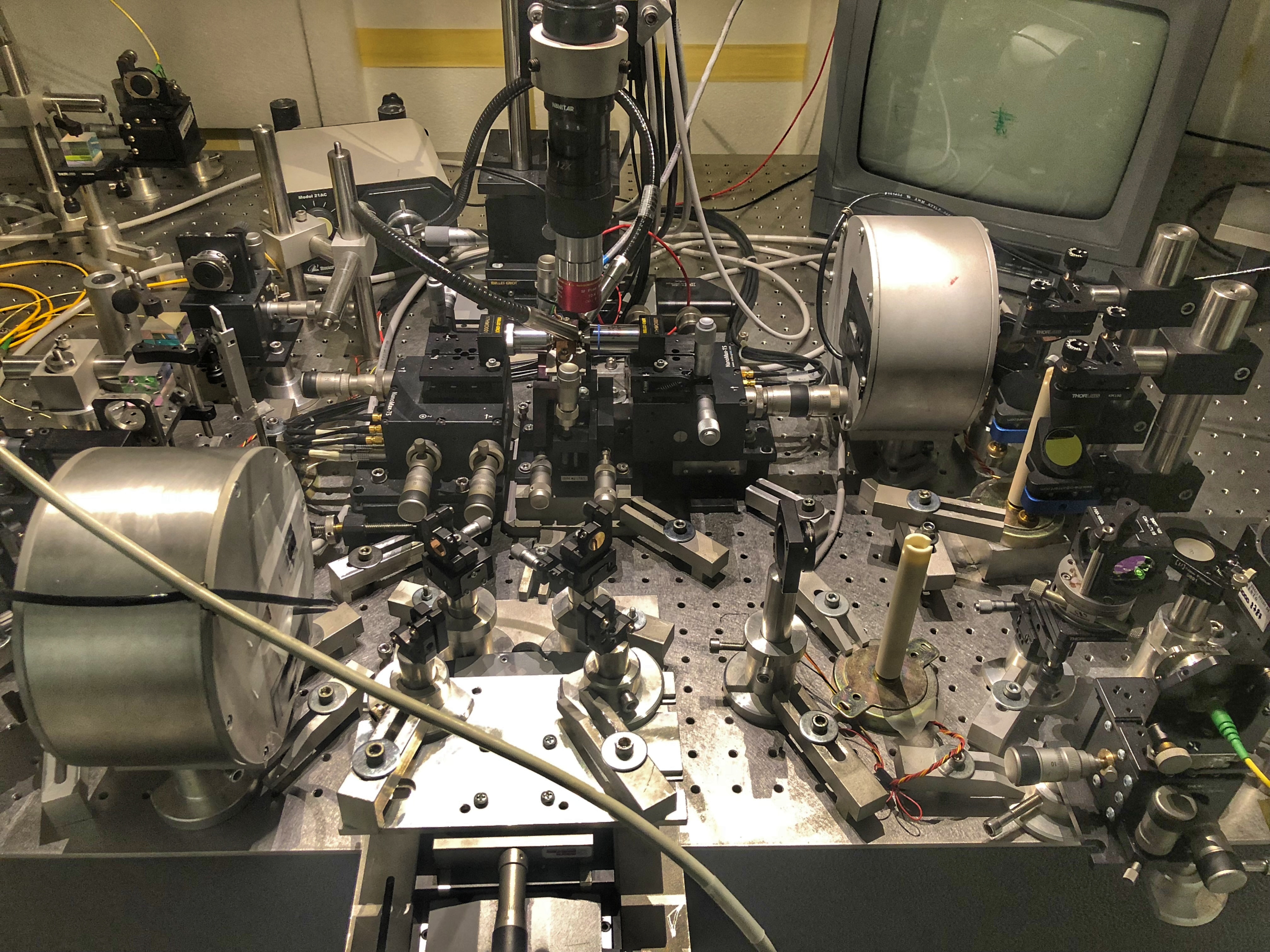 Lab is dedicated to the phase measurement of light-wave circuits. A novel phase sensitive set-up based on a free space Mach-Zehnder interferometer allows measuring simultaneously the transmitted intensity and phase shift of generic optical integrated circuits. In this way, the transmitted intensity are completed by the knowledge of the phase. The interferometer allows us to perform both characterization measurements in the linear regime and Pump and Probe measurements in the non-linear one. The possibility to detect the signal response by means of a Lock-in Amplifier not only decreases the signal to noise ratio but also allows filtering the Probe from the Pump signal even if they have the same wavelengths. Systematic and stable measurements are ensured by a full remote control of the interferometer and by enclosing it into a box. A detailed description of the optical set-up is reported in the ref. [1].
Lab is dedicated to the phase measurement of light-wave circuits. A novel phase sensitive set-up based on a free space Mach-Zehnder interferometer allows measuring simultaneously the transmitted intensity and phase shift of generic optical integrated circuits. In this way, the transmitted intensity are completed by the knowledge of the phase. The interferometer allows us to perform both characterization measurements in the linear regime and Pump and Probe measurements in the non-linear one. The possibility to detect the signal response by means of a Lock-in Amplifier not only decreases the signal to noise ratio but also allows filtering the Probe from the Pump signal even if they have the same wavelengths. Systematic and stable measurements are ensured by a full remote control of the interferometer and by enclosing it into a box. A detailed description of the optical set-up is reported in the ref. [1].